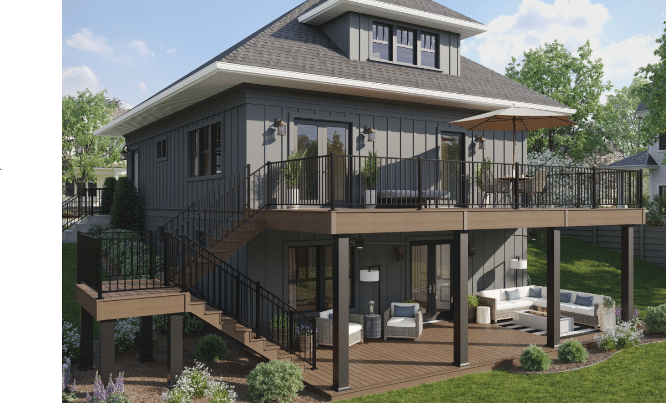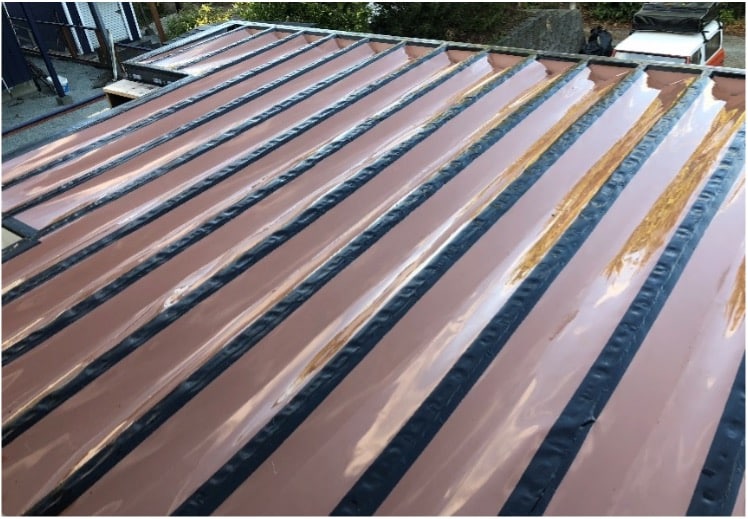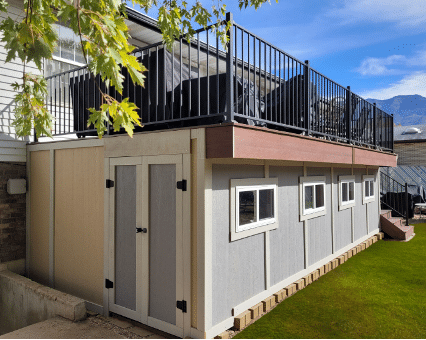Outdoor living space and ample storage are among the most sought-after amenities by today’s homeowners and prospective homebuyers. In both cases, the space beneath an elevated deck can offer an ideal solution. With the addition of an under-deck drainage system, this space can become usable for a multitude of purposes and activities.
Using a network of troughs and downspouts, a deck drainage system captures and diverts water away from the deck to protect the substructure from moisture and create a dry, usable space beneath an elevated deck. These systems act like shingles on a roof to shield the wooden foundation from moisture penetration and damage. Without protection, an average wood substructure can begin to deteriorate after just 10 years, whereas a deck drainage system can extend the life of both the deck and its framing for decades.
Once protected, the area below the deck surface can be used like any room inside a house. Homeowners can add electricity, water, and gas lines, as well as furniture, lighting, ceiling fans, and entertainment components to create additional outdoor living space. This area also is ideal for use as bonus storage space.
The Ins, Outs, and Downspouts of Deck Drainage Systems
While there are numerous options for under-deck drainage systems with various configurations, components, and price points, these systems broadly fall into one of two categories – those that are installed beneath the substructure framing and those that are applied above the joists.
Below-the-joist systems consist of metal or vinyl panels retrofitted to the underside of the deck’s joists, with the panels sloping to a gutter installed at the deck beam for drainage. Advocates of this type of system will tout that installation does not require the dismantling of an existing deck. A disadvantage of these systems, however, is that they leave wood and metal exposed to the elements, making them more susceptible to water damage and corrosion. This type of system can also trap moisture in the core supports of the substructure, which can accelerate the rotting and deterioration of the structure.
For optimal protection and aesthetics, most contractors prefer drainage systems that install above the joists between the substructure and deck boards. This method uses poly or rubberized membranes that drape over the joists and down into each joist bay from above the substructure, ensuring that the entire substructure is shielded from moisture penetration. Furthermore, the membrane material (as opposed to metal, vinyl, or PVC) accommodates a broader range of ceiling options for homeowners seeking a finished aesthetic.
In both cases, deck drainage systems are relatively simple to install and require minimal tools. Trex® RainEscape®, for instance, is an above-the-joist system that includes just five SKUs and can be installed using a stapler, utility knife, and caulk. Each trough is clearly labeled with staple markers to expedite the process, which takes no more than a few hours to complete, depending on the size of the deck.
Unlimited Potential
With a drainage system in place, the possibilities for utilizing the space below a deck are virtually limitless. Here are just a few:
- Patio Paradise. Create an outdoor area with all the comforts of the indoors. Install a ceiling with recessed soffit lights to create the look and feel of a finished room. Pair plush upholstered furnishings in weather-resistant fabrics with decorative accents and add outdoor curtains for enhanced style and privacy.
- Al Fresco Dining. Take any meal from ordinary to extraordinary by moving it outdoors. With the Trex RainEscape system, gas lines and electrical wiring can be run safely and discreetly between the deck surface and a soffit ceiling, accommodating whatever may be on the menu.
- Game Day Getaway. Shielded from the elements and outfitted with comfortable furnishings, a wet bar, and a mounted flat screen television, the space beneath a deck offers the perfect place for watching the big game or catching up on the latest binge-worthy show with family and friends.
- A Room for All Seasons. Why create a space that clients can only enjoy for a few months? By enclosing the area beneath an elevated deck with windows and screens, homeowners can enjoy the great outdoors in comfort, no matter the season or the weather.
- Store in Style. When properly protected, the space beneath a deck is ideal for storage. Seasonal items such as pool equipment, gardening tools, patio furniture, and yard games can be safely tucked away. Size permitting, this space can even be used to house grills, lawnmowers, bicycles, ATVs, and snowmobiles.
Boost Revenue and Referrals
An under-deck drainage system is an upgrade that enables builders to drive increased profit potential without hiring additional employees. Assuming a margin of 20% on a 325-square-foot deck, a builder can potentially earn a few thousand dollars more by adding an under-deck drainage system to a project. Over the course of a year, these minor increases can have a major impact on their bottom line.
The best part is that an under-deck drainage system is an upgrade that builders can feel confident selling. While it may increase the cost of a deck project, most homeowners find it a worthwhile investment – especially after the first rainfall, when they experience firsthand the value of having a dry outdoor living space they can enjoy even in inclement weather. Additionally, protecting the structural integrity of their deck’s substructure affords homeowners peace of mind and satisfaction that can lead to referrals and more business.
For more information about under-deck drainage, visit www.trexrainescape.com.





